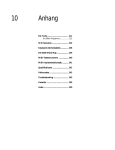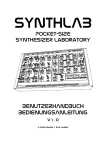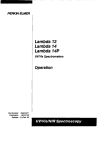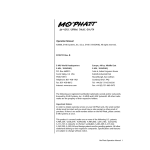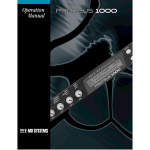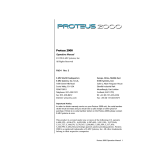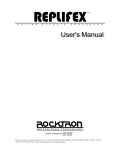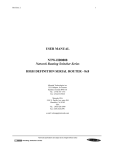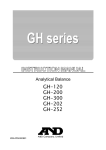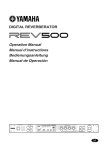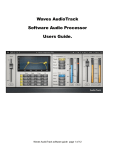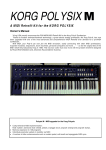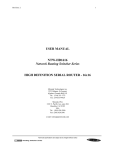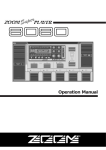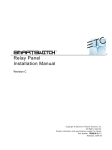Download Owner`s Manual
Transcript
Owner's Manual LXP-5 Effects Processing Module Owner's Manual LXP-5 Effects Processing Module Unpacking and Inspection After unpacking the LXP-5, save all packing materials in case you ever need to ship the unit. Thoroughly inspect the LXP-5 and packing materials for signs of damage. Report any shipment damage to the carrier at once; report equipment malfunction to your dealer. Notice This equipment generates and uses radio frequency energy and if not installed and used properly, that is, in strict accordance with the manufacturer's instructions, may cause interference to radio and television reception. It has been type tested and found to comply with the limits for a Class A computing device in accordance with the specifications in Subpart J of Part 15 of FCC Rules, which are designated to provide reasonable protection against such interference in a residential installation. However, there is no guarantee that interference will not occur in a particular installation. If this equipment does cause interference to radio or television reception, which can be determined by turning the equipment OFF and ON, the user is encouraged to try to correct the interference by one or more of the following measures: Reorient the receiving antenna Relocate the computer with respect to the receiver Move the computer away from the receiver Plug the computer into a different outlet so that the computer and receiver are on different branch circuits. If necessary, the user should consult the dealer or an experienced radio/television technician for additional suggestions. The user may find the following booklet prepared by the Federal Communications Commission helpful: "How to identify and Resolve Radio/TV Interference Problems." This booklet is available from the U.S. Government Printing Office, Washington, DC 20402, Stock No. 004-000-00345-4. Copyright 1989, 1995 All Rights Reserved. Lexicon Part #070-07332 Rev 1 Lexicon Inc. 3 Oak Park Bedford, MA 01730USA Telephone 781-280-0300 Fax 781-280-0490 Table of Contents Introduction 1. Installing the LXP-5 Unpacking .......................................................................... 1-1 Mounting ............................................................................ 1-1 Power ................................................................................ 1-1 Front Panel Controls .......................................................... 1-2 Rear Panel Connectors ..................................................... 1-3 Audio Connections ............................................................ 1-4 2. Front Panel Operation Setting Audio Levels .......................................................... 2-1 LED Signals ....................................................................... 2-3 Selecting Preset Programs ................................................ 2-4 User Memory ..................................................................... 2-7 Creating Your Own Sounds ............................................. 2-11 Storing and Recalling sounds .......................................... 2-19 Footswitch Operation ....................................................... 2-22 3.MIDI Operation Accessing Programs .......................................................... 3-1 Patches and Dynamic MIDI .............................................. 3-4 Creating Patches Using MIDI SysEx Data ...................... 3-11 Assigning Switches as Control Sources .......................... 3-12 4. MIDI Implementation Data Data/Event Requests ......................................................... 4-1 Transmit/Receive Data ...................................................... 4-2 Parameter Definitions ........................................................ 4-6 Microcode Parameters ...................................................... 4-9 Implementation Chart ...................................................... 4-14 5. Specifications User Program Log Sheet Introduction Congratulations on your purchase of the LXP-5 Effects Processing Module! You are about to experience superb sound quality, a full range of pitch shifting, delay and reverb effects, fast intuitive editing of preset sounds, and an industry-leading MIDI implementation. The LXP-5 offers a rich and distinctive palette of special effects, including 128 programs to get you started — 64 preset effects programs and an additional 64 programs stored in RAM user memory locations. Each program has up to five variable parameters that you can adjust for subtle or dramatic changes in the program’s sound, and you can store as many as 128 customized programs in user memory. All of the LXP-5 functions are accessible from the front panel, or via MIDI, providing truly world-class flexibility and control. From pitch shifting to stereo delays and flanging, the LXP-5 delivers superior performance. Whether you are a producer, engineer, or musician—whether you work on stage or in the studio—the LXP-5 will quickly become an indispensible part of your sound. We’re confident you’ll find that the LXP-5’s unique combination of state-ofthe-art sound and extraordinary versatility is exactly what you’re looking for. A Quick Reference card provides the basics of operation in a compact format to get you up and running as quickly as possible — but to make sure you don’t miss out on anything, we’d like you to read this manual. It provides a thorough explanation of both front panel and MIDI operation, program descriptions, and complete MIDI Implementation data — all the information you need to access the full power of the LXP-5. Installing the LXP-5 1. Installing the LXP-5 Unpacking After unpacking the LXP-5, save all packing materials in case you ever need to ship the unit. Thoroughly inspect the LXP-5 and packing materials for signs of damage. Report any shipment damage to the carrier at once. The following accessories are included with the LXP-5: 1. 2. 3. 4. Quick Reference card Owner's Manual Power pack (USA Part # 470-07345) Warranty card (USA only) Mounting The LXP-5 measures 8.5"W x 1.7"H x 9.5"d (215.9 x 43.2 x 241.3 mm). The optional rack mounting kit (A-LXP-R) handles one or two units in a single rack space. Whatever mounting method you use, make sure that the LXP5 is securely screwed into the rack adapter – "friction fit" or double-stick tape installations may allow units to loosen during transportation, resulting in damage. The maximum ambient operating temperature is 35°C (95°F). Provide adequate ventilation if the LXP-5 is mounted in a closed rack with heatproducing equipment such as synthesizer modules, effects units, or power amplifiers. Avoid mounting the LXP-5 directly above power amplifiers. Power Connect the LXP-5 power pack to an appropriate AC wall socket, and the cable end to the LXP-5 power connector. The LXP-5 must be used only with the supplied power pack. Voltage requirements are printed on the power pack. The LXP-5 has no power switch – it can be left on all the time. To keep the power plug from working loose from the rear of the unit during transport, you may wish to apply a small amount of silicone sealer to the plug after inserting it. 1-1 LXP-5 Owner's Manual LXP-5 Front Panel Controls Input Sets the audio input level. Mix Controls the ratio of dry (source) to wet (effect) signal present at the LXP-5 outputs. (Turn the control all the way to the left for 100% dry/ 0% wet.) Learn This button is used to store and edit programs, to learn patches and, with an external MIDI device, to select MIDI channel. Output Controls the signal level sent to the LXP-5 outputs. Learn LED Confirms that power is on, and blinks in red or green at different rates to indicate LXP-5 status. exicon LXP-5 INPUT MIX OUTPUT PRESET PITCH DELAY CHORUS MULTI EDIT A B C BYPASS Level Indicators The left LED indicates signal present; the right flashes red when the signal is -3dB from peak overload. 1-2 USER SELECT LEARN 1 2 3 4 5 6 7 8 Function and Select Used for selection of factory presets, User memories, Bypass and three edit modes. Adjust Used to adjust program parameter(s), or to adjust the selected parameter in Edit Mode. Installing the LXP-5 LXP-5 Rear Panel Connections MIDI IN Receives MIDI information from other MIDI equipment such as master keyboard controllers, MIDI foot controllers, sequencers and synthesizers. Dynamic MIDI® FOOTSWITCH MIDI IN OUT - THRU MIDI THRU (OUT) With the recessed slide switch set for MIDI THRU, any MIDI data received is sent without change. The recessed slide switch can also be set for MIDI OUT. Outputs (L and R) Single-ended (unbalanced) stereo outputs provide +4dBu nominal output level. Footswitch Connector for toggle (Push on/push off) or momentary contact footswitch. OUTPUTS POWER 9V AC 1.5A LEXICON LXP-5 ASSEMBLED IN HONG KONG L INPUTS R L R THIS EQUIPMENT COMPLIES WITH THE REQUIREMENTS IN PART 15 OF FCC RULES FOR A CLASS A COMPUTING DEVICE Power Accepts power from the supplied power pack. Inputs (L and R) Single-ended (unbalanced) inputs accept levels from -25 to +20dBu. Input impedance is 50 kilohms in stereo, 25 kilohms in mono. 1-3 LXP-5 Owner's Manual Audio Connections This section outlines several connection possibilities for the LXP-5. Because each sound system is unique, we recommend experimentation to arrive at the best configuration for your system. Always check connections for proper impedance, polarity, and levels. Audio connections to the LXP-5 are unbalanced, and should be made with high quality shielded cables with 1/4" tip-sleeve phone jacks at the LXP-5 end. The connectors must be wired as shown below: Sleeve - Shield/Ground Tip - High If only 1/4" tip-ring-sleeve phone jacks are available, they must be wired as shown: Sleeve - Shield/Ground Tip - High Ring - Connect to Sleeve Mono or stereo? The LXP-5 produces wonderful stereo effects from either mono or stereo signal sources. For mono sources, use either of the two input connectors; the dry signal appears (along with the stereo effects) in mono at both output connectors. For instruments and sources with stereo outputs, use both inputs. We recommend using both LXP-5 outputs whenever possible but, if mono output is required, you can use just one of the two output connectors. When only one output is used, the left and right signals are summed internally . Some of the examples on the following pages use stereo instruments and amplification systems, others use mono. Feel free to adapt the examples to your specific requirements. 1-4 Installing the LXP-5 Channel Input or Effects Return (R) Channel Input or Effects Return (L) Effects Send Input (L or R) L Output R Output exicon LXP-5 INPUT MIX OUTPUT PRESET PITCH DELAY CHORUS MULTI EDIT A B C BYPASS USER SELECT LEARN 1 2 3 4 5 6 7 8 Connection to a mixing console's effects sends If you will be using an LXP-5 as your primary effects unit, and your system includes a console with one or more auxiliary (effects) sends, connect the LXP-5 as shown above. In most applications, it is preferable to connect the LXP-5 outputs to two of the console's input channel strips, panned full left and right, rather than the effects returns. This allows the greatest flexibility in routing and equalization. In this configuration the console controls are used to set the amount of effect heard—the LXP-5 front panel MIX control should be set fully clockwise for 100% wet. 1-5 LXP-5 Owner's Manual Channel Input (pan right) Channel Input (pan left) LXP-5 L Output LXP-5 R Output exicon LXP-5 INPUT MIX PRESET PITCH DELAY CHORUS MULTI OUTPUT EDIT USER A B C BYPASS In Synth L Output SELECT LEARN 1 2 3 4 5 6 7 8 In Synth R Output Connection between instrument and console In some applications (such as when an LXP-5 is used for a single instrument) it may be desirable to patch the LXP-5 between the instrument and console. This makes it possible to keep the LXP-5 up on stage with other MIDI gear, rather than in the console effects rack, making MIDI control much easier. In this configuration, the LXP-5 front panel MIX control is used to set the balance between wet and dry sound. 1-6 Installing the LXP-5 Guitar Output exicon LXP-5 INPUT LXP-5 Input (L or R) Amp L Input MIX OUTPUT PRESET PITCH DELAY CHORUS MULTI EDIT A B C BYPASS LXP-5 L Output USER SELECT LEARN 1 2 3 4 5 6 7 8 LXP-5 R Output Amp R Input Connection between instrument and amplifier For a very spacious guitar sound, connect the LXP-5 between a guitar and two amp and speaker stacks. The only problem with this setup is that if you use overdrive distortion created by the amplifier, changing settings on the LXP-5 also affects the quantity and quality of your distortion. If you use a separate distortion box, you can get around this problem by connecting it before the LXP-5. If you prefer amplifier-generated distortion, try the setup shown on the next page. 1-7 LXP-5 Owner's Manual WARNING! Never connect speaker outputs from a guitar amp to the LXP-5. Doing so can cause serious damage which is not covered by the LXP-5 warranty. On some guitar amplifiers it is very easy to accidentally use a speaker output instead of a direct or effects output. BE CAREFUL! Guitar Output Amp or Preamp Input Direct or Preamp output LXP-5 Input (L or R) exicon LXP-5 INPUT MIX OUTPUT PRESET PITCH DELAY CHORUS MULTI EDIT A B C BYPASS LXP-5 L Output Amp L Input USER SELECT LEARN 1 2 3 4 5 6 7 8 LXP-5 R Output Amp R Input L and R Speaker Outputs from Power Amp Connection between instrument preamp and power amplifier(s) If you use overdrive distortion, it's usually better to create the overdrive before sending the signal to the LXP-5 to ensure that the effects don't change the quantity and quality of your distortion. In this setup, you need a guitar preamplifier or a guitar amp with a direct output. Feed this signal to either of the LXP-5 inputs, and then on to a stereo power amp or a pair of guitar amps. (A few guitar amplifiers become unhappy if they are operated without speakers connected. Consult the amp manufacturer for details.) You can use the effects send and return connectors on a mono guitar amp to obtain similar results. Adjust the LXP-5 output level so that the amp produces the same output with the LXP-5 as it does without it. 1-8 Installing the LXP-5 Console Inputs Console Inputs LXP-5 Outputs (L and R) LXP-5 Outputs (L and R) exicon LXP-5 INPUT MIX OUTPUT PRESET PITCH DELAY CHORUS MULTI EDIT A B C BYPASS USER SELECT LEARN 1 2 3 4 5 6 7 8 exicon LXP-5 INPUT MIX OUTPUT PRESET PITCH DELAY CHORUS MULTI EDIT USER A B C BYPASS SELECT LEARN 1 2 3 4 5 6 7 8 LXP-5 L Input LXP-5 Inputs (L and R) Drum machine's stereo outputs Drum machine's individual output for snare drum Connection between drum machine and console Using two LXP-5 units between your drum machine and console can make your drum machine sound much more exciting, since it allows you to process the all-important snare drum separately from the rest of the mix. Make sure you remove the snare from the drum machine's main stereo mix. 1-9 LXP-5 Owner's Manual 1-10 Front Panel Operation 2. Front Panel Operation Setting audio levels The wide range of adjustment available with the LXP-5 INPUT and OUTPUT LEVEL controls allow it to be used with virtually any kind of equipment found in the studio or on the road. To set audio levels: 1. Turn the LXP-5 INPUT and OUTPUT LEVEL controls all the way down (fully counterclockwise). 2. Set the instrument output, preamp output, or effects send that feeds the LXP-5 input(s) to a nominal level. With an instrument, this should be your loudest normal playing level; with a preamp output or console, adjust the output(s) or effects send(s) to produce the highest level possible with the least amount of noise. If the output you are using doesn't have a level control, don't worry about it! 3. While sending audio to the LXP-5, gradually turn up the INPUT LEVEL control until the green SIGNAL PRESENT LED lights. Continue to advance INPUT LEVEL until the red PEAK LED just flashes on the loudest peaks. If it flashes continously, reduce INPUT LEVEL slightly.This ensures the best possible signal-to-noise ratio and dynamic range. PEAK LED flashes on peaks; INPUT LEVEL should be set to the level where the PEAK LED flashes briefly on the loudest peaks only SIGNAL PRESENT LED should be lit exicon INPUT MIX Note: If the PEAK LED flashes with no input present (i.e., during reverb delay line feedback, it indicates processor overload is occurring. 2-1 LXP-5 Owner's Manual 4. If the LXP-5 inputs are connected to a console effects send, and the outputs are connected to console channel strip inputs, set the console's input level trim and fader to a setting typically used for line level inputs. Then set the MIX control fully clockwise (100% effect) and gradually turn up the LXP-5 OUTPUT LEVEL control until the right amount of audio is present at the console. n INPUT MIX OUTPUT MIX setting to use when the LXP-5 is patched to console effects send(s) 5. If you are using an instrument amplifier or preamplifier, start with the LXP-5 MIX control straight up (50% effect). Gradually increase the OUTPUT LEVEL control until the audio level heard from the amplifier is approximately the same as when the LXP-5 is not connected. The best setting for MIX depends on which program you are using, and to a great extent, your personal taste; feel free to experiment. n INPUT 2-2 MIX OUTPUT When using an instrument amplifier or preamplifier, the ideal MIX setting is generally somewhere in this range Front Panel Operation LED signals The front panel LEARN indicator is a bicolor (red/green) LED that performs several functions: Register Store: success or failure The LEARN LED will blink at a 6 Hz rate for approximately 2 seconds — in green to indicate succesful register storage, red to indicate failure to store to a register. MIDI Data Present The LEARN LED will flicker (in whatever its current color) to indicate LXP5 recognition of incoming MIDI messages. System Common messages, non-LXP-5 SysEx messages and any message on channels other than the selected channel will not activate the LED. Parameter Editing Status When not receiving MIDI, or indicating storage success, the LED will tell you two things about the parameter editing status of the sound you are running: 1. Has the selected parameter been changed from the stored value? If the selected parameter matches the stored value, the LED will be green. Otherwise it will be red. 2. Do the knobs correctly indicate the sound that is running? If the knobs are accurate the LED will be steady. If the knobs are not accurate (for example, after loading a program or changing the selected parameter via MIDI), the LED will blink. GREEN RED LED Steady Parameter Unchanged Knobs Accurate Parameter Changed Knobs Accurate LED Blinks Parameter Changed Knobs Inaccurate Parameter Unchanged Knobs Inaccurate 2-3 LXP-5 Owner's Manual Presets and User Programs Selecting LXP-5 preset programs Any one of 64 preset effects programs can be selected by turning the FUNCTION and SELECT knobs on the front panel. To select a preset, first turn FUNCTION to one of the four available preset types: PITCH, DELAY, CHORUS or MULTI(-effect). Then, turn SELECT to one of the 16 presets within the chosen type. Use FUNCTION to select a preset type. PRESET PITCH DELAY CHORUS MULTI EDIT A B C BYPASS Use SELECT to choose a specific preset. USER SELECT 1 2 3 4 5 6 7 8 Once a preset has been chosen, the sound can be modified with the ADJUST knob. Program parameters can be altered in Edit mode, described later in this chapter. Use ADJUST to change the sound of the preset. LXP-5 LEARN 2-4 Front Panel Operation LXP-5 Presets PITCH SELECT Position MIN 2 3 4 5 6 7 8 9 10 11 12 13 14 15 MAX PRESET # 1 2 3 4 5 6 7 8 9 10 11 12 13 14 15 16 ADJUST Name Parameters Fourth Down Pitch Interval Fifth Up Pitch Interval Octave Down Pitch Interval Two Octaves Down LFO Rate Octave Up LFO Rate Tunnel Up Dly 2,3-crs,Rvb Bal,Pitch Adj Tunnel Down Dly 2,3-crs,Rvb Bal,Pitch Adj Glissando Up Dly 2,3-crs,Decay Time,Pitch Intrvl Glissando Down Dly 2,3-crs,Decay Time,Pitch Intrvl Diminished Dly 2,3-crs,Decay Time Suspended Dly 2,3-crs,Decay Time Low Octave Pitch Interval Mid Octave Pitch Interval High Octave Pitch Interval Semitune Pitch Adjust Fine Tune Pitch Adjust DELAY SELECT Position MIN 2 3 4 5 6 7 8 9 10 11 12 13 14 15 MAX PRESET # 17 18 19 20 21 22 23 24 25 26 27 28 29 30 31 32 Name Echo Delay Stereo Delay Slap Echo Mid Slap Stereo Slap Diffuse Echo Image Delay Bounce Delay Bounce Loop Ambient Loop Echo Loop Filter Delay Robot 1 Robot 2 Short Delay Long Delay ADJUST Parameters Dly 1,2-crs,Rvb Bal Dly 1,2-crs,Rvb Bal,Fbk 1 Decay Time,Dly 2-crs,Fbk 1 Decay Time,Dly 1,2-crs,Fbk 1 Decay Time,Dly 1,2-crs Decay Time,Dly 1,2-crs,Fbk 1 Decay Time,Dly 1,2-crs,Fbk 1 Dly 1,2-crs,Fbk 1 Dly 1,2-crs,Fbk 1 Dly 1-crs,Fbk 1 Dly 1-crs,Fbk 1 Dly 1-crs,Fbk 1 Dly 1-fin,Dly 2-crs,Fbk 1 Dly 1-fin,Dly 2-crs,Fbk 1 Dly 1-crs Dly 1-crs 2-5 LXP-5 Owner's Manual CHORUS SELECT Position MIN 2 3 4 5 6 7 8 9 10 11 12 13 14 15 MAX PRESET # 33 34 35 36 37 38 39 40 41 42 43 44 45 46 47 48 Name Chorus Ambient Image Comb Ambience Ambient Detune Dry Detune Slap Detune Resonant Sweep Diffuse Sweep Slap Sweep Echo Detune Step Detune Roto Motion Roto Slap Slow Res. Sweep Slap Flange Diffuse Flange ADJUST Parameters Pitch Adj,Dly 3-crs Dly 3-crs,Decay Time,Rvb Time Dly 2,3-crs,LFO Rate Dly 2,3-crs,LFO Rate Dly 2,3-crs,LFO Rate Dly 1,3-crs,LFO Rate Dly 1,3-crs,LFO Rate Dly 1,3-crs,LFO Rate Dly 1,3-crs,LFO Rate Dly 1,3-crs,LFO Rate Dly 3-crs LFO Rate,Patch 3 (LFO to Dly 2-fin) LFO Rate,Patch 3 (LFO to Dly 2-fin) Rvb Bal,Patch 3 (LFO to Dly 2-fin) Rvb Bal,Patch 3 (LFO to Dly 2-fin) LFO Rate,Patch 3 (LFO to Dly 2-fin) MULTI SELECT Position MIN 2 3 4 5 6 7 8 9 10 11 12 13 14 15 MAX 2-6 PRESET # 49 50 51 52 53 54 55 56 57 58 59 60 61 62 63 64 Name Strange Room Down Room Ambient Slap Slow Rise Slow Fall Octave Room Zoom Bounce Fourth Slap Room Echo Room Dark Closet Small Bright Medium Bright Medium Dark Large Bright Huge Room ADJUST Parameters Dly 2-crs,Pitch Adj,Fbk 2 Pitch Adj,Fbk 2 Dly 2-crs,Decay Time Dly 2-crs,Fbk 2,Hicut Dly 2-crs,Dly 3-fin,Fbk 2,Locut Fbk 2,Hicut,Decay Time Fbk 2,Pitch Interval Dly 2-crs,Fbk 1,Bass Mult,Dcy Time Dly 2-crs,Fbk 1,Bass Mult,Dcy Time Dly 2-crs,Fbk1,Rvb Bal,Decay Time Treble Decay,Hicut,Decay Time Decay Time Decay Time Decay Time Dly 2-crs,Decay Time Dly 2-crs,Decay Time Front Panel Operation User Memory The LXP-5 contains 128 memory locations divided among 8 User Memory Banks as follows. USER 1 USER 2 USER 3 USER 4 1-16 17-32 33-48 49-64 USER 5 USER 6 USER 7 USER 8 65-80 81-96 97-112 113-128 NOTE: All User programs are volatile — storing a new program will overwrite the previously stored program. When shipped from the factory, THE LXP-5 contains a duplicate set of the Preset programs at locations 1-64 (available at FUNCTION settings: USER 1-4). Sixty-four different programs are provided at locations 65-128. These programs make use of both ADJUST Knob patches and MIDI patches (described in Chapters 3 and 4). These User presets, provided in User Banks 5-8, are shown in the following tables. . 2-7 LXP-5 Owner's Manual USER BANK 5 SELECT Position MIN 2 3 4 5 6 7 8 9 10 11 12 13 14 15 MAX PRESET # 65 66 67 68 69 70 71 72 73 74 75 76 77 78 79 80 Name Doppler Room Knot Octave Back Pan Delay Verb After Pitch Velodelay Shimmer Little Pan Pan Echo Spread Echo Trade Off Veloverb Plate Chorus Drum Teel Infinite Reverb Infinite Loops PATCH Assignments Knob: Decay Time Knob: Decay Time Knob: Fbk 2, Decay Time Knob: Feedback 2 Knob: Fbk 2; MIDI Velocity: Dly 2 Knob: Fbk 2; MIDI Aftertouch: Pitch Adjust Knob: Decay Time Knob: Decay Time Knob: Decay Time Knob: Decay Time Knob: Delay 1-coarse Knob: Rvb Bal MIDI Velocity: Rvb Time Knob: Reverb Balance Knob: Feedback 2 Knob: Decay Time Knob: Delay 1-coarse USER BANK 6 SELECT Position MIN 2 3 4 5 6 7 8 9 10 11 12 13 14 15 MAX PRESET # 81 82 83 84 85 86 87 88 89 90 91 92 93 94 95 96 PATCH Name Assignments Clocked Descend* Knob: Pitch Interval;MIDI Clock: Fbk 2 Clocked Slap* Knob: Fbk 2; MIDI Clock: Delay 2-coarse Clocked Rvb Flange* Knob: Rvb Bal; MIDI Clock: Dcy, LFO Rate Shimmer Cave Knob: Delay 2-coarse, Delay 3-coarse Vibrato Scale Knob: LFO-Pitch Scaling Random Flange Knob: LFO-Delay 2 Scaling Mystery Pitch Knob: Pitch Adjust Two Octave Delay Knob: Dly 1-crs, Dly 3-crs, Rvb Bal Doppler Flange Knob: Feedback 1 Stadium Knob: Delay 2-coarse, Feedback 2 Vibra Verb Knob: Decay Time, Delay 2-coarse Wait Frash Knob: Decay Time Chromatic Knob: Decay ; MIDI Pitch Bend: Pitch Adjust Doppler Mod Knob: Delay 2-coarse; Decay Time Dark Chorus Verb Knob: Delay 2-coarse; Feedback 2 Bent Knob: Decay Time; MIDI Velocity: Dly 2-crs *Drum Machine Program — requires MIDI Clock input 2-8 Front Panel Operation USER BANK 7 PRESET SELECT Position MIN # 97 2 98 3 99 4 100 5 101 6 7 8 9 10 11 12 13 14 15 MAX 102 103 104 105 106 107 108 109 110 111 112 PATCH Assignments Knob: Decay , Dly 2-crs, Bass Multiply; MIDI Last Note: Pitch Interval, Treble Decay Stavid* Knob: Decay ; MIDI Last Note: Pitch Interval, Treble Decay Note Spread* Knob: LFO-Dly 2,3-Scaling MIDI Last Note: Delay 2,3 Mono Drum Delay** Knob: Reverb Bal,ance Delay 2-coarse; MIDI Clock: Delay 1-coarse Stereo Drum Delay** Knob: Delay 2,3-coarse MIDI Clock: Delay 2,3 Octave Vibrato Knob: Pitch Interval Shaky Five Knob: LFO Rate, Feedback 2 Ganged Echo Knob: Delay 2,3-coarse Ambecho Knob: Decay Time Jaco Chorus Knob: Pitch-Fine Double Up Knob: Feedback 2 Canyon Echo Knob: Delay 1,2-coarse Spiral Echo Knob: Delay 1,2-coarse, Pitch Adjust Ho Drum Knob: Pitch Adjust Body Snatchers Knob: LFO Rate Glass House Knob: Treble Decay, Hicut, Bass Multiply Name Animal Orchestra* *Apply MIDI input from keyboard for best results **Drum Machine Program — requires MIDI Clock input 2-9 LXP-5 Owner's Manual USER BANK 8 PRESET SELECT Position MIN 2 # 113 114 3 115 4 116 5 117 6 118 7 8 119 120 9 10 121 122 11 123 12 13 14 15 124 125 126 127 MAX 128 PATCH Assignments Knob: Dly 2-crs; MIDI Velocity: Fbk 2 Knob: Dly 2,3-crs; MIDI Last Note: Pitch Adjust (Notes above middle C ascend; notes below descend) Key Delayverb* Knob: Ptch Adj; MIDI Last Note: Dly2-crs, Fbk 2, Dcy Time (Last Note affects Dly/Fbk and reverb) Sustain Pedal Loop Knob: Delay 1-coarse; MIDI Sustain Pedal: Input Level, Fbk 1 (Pedal On will cause infinite loop and mute audio input to loop) Note Flange Knob: Reverb Balance; MIDI LAST Note: Delay 1-fine, Feedback 1 (Last Note controls flange) Afterflange Knob: Fbk 1; MIDI Aftertouch: Dly 1-fine (Aftertouch controls flange) Phase Flange Knob: Delay 1-fine Phase Pedal Knob: Delay 1,2-fin; MIDI Sust Pdl: Dly 1-fin (Pedal has phase effect on audio) Huge Fourth Knob: Treble Decay, Delay 2-fine Upper Noted Knob: Pitch Adjust; MIDI Last Note: Dly 2-crs, Fbk 2 (Last Note causes upper notes to have a delayed effect with feedback) Detune Loop Knob: Ptch Adj; MIDI Sust Ped: Input Lvl (An almost infinite loop — input level is muted by sustain pedal) Sky Knob: Feedback 2 Phasecho Knob: Delay 2-fine Feedback Sampler** Knob: Feedback 1; MIDI Last Note: Pitch Ambient Sampler** Interval; MIDI Volume: Output Level Knob: Feedback 1: MIDI Last Note: Pitch Sampler** Interval; MIDI Volume: Output Level Name Velo Ripple Keycend *Apply MIDI input from keyboard for best results ** Set Knob from MIN to MAX to cause current audio to loop continuously. 2-10 Front Panel Operation Creating your own sounds The LXP-5 contains two algorithms which are used to create its many different and interesting sounds: Pitch/Delay which includes a digital delay line, pitch shifter, EQ and ambience Delay/Reverb which includes a digital delay line, EQ and reverb. Pitch/Delay Block Diagram Feedback 2 Delay 2 Feedback 1 Audio Input Pitch Shifter Delay 1 + Ambience Output R Reverb Balance EQ Output L + Delay 3 Delay/Reverb Block Diagram Feedback 1 Audio Input EQ Delay 1 (Modulation) + Delay 2 (Pre-Delay) Diffusor Reverb Output R Reverb Balance + Output L 2-11 LXP-5 Owner's Manual The available parameters for each preset are determined by the algorithm used. All PITCH, DELAY, CHORUS and MULTI presets 49-56 use the Pitch/Delay Algorithm. MULTI presets 57-64 use the Delay/Reverb algorithm. Editing a preset The easiest way to start creating your own sounds is by editing one of the 64 LXP-5 preset programs. Use FUNCTION and SELECT to choose a preset you would like to change. Put the LXP-5 into Edit mode by holding the LEARN button in while turning FUNCTION to EDIT A or B, then releasing the LEARN button. (The parameters available at EDIT C are discussed in Chapter 3: MIDI Operation.) Turn SELECT to the parameter you wish to edit. The parameter value can now be modified with the ADJUST knob. (Move ADJUST to a new setting to activate it.) The following tables show all of the parameters available at FUNCTION settings EDIT A and EDIT B. The algorithm used for each parameter is also shown, with the available range of values, and the appropriate setting of the SELECT knob. 2-12 Front Panel Operation Parameters available at EDIT A DELAY SELECT Position MIN 2 3 4 5 6 E 7 D 8 I T Name Delay 1-Coarse Delay 1-Fine Feedback 1 Delay 2-Coarse Delay 2-Fine Feedback 2 Delay 3-Coarse Delay 3-Fine PARAMETER Range Pitch/Delay Delay/Reverb 0-983 ms 0-630.8 ms (1) 0-61.5 ms 0-61.5 ms (1) 0-100% 0-100% 0-307.2 ms 0-307.2ms (2) 0-19.2 ms 0-19.2 ms (2) 0-99% NA 0-307.2 ms NA 0-19.2 ms NA PITCH A Name 9 Pitch Base Select 10 Pitch Interval 11 Pitch Adjust PARAMETER Range Pitch/Delay MIN-4=Bypass/5-8=down 2 Oct/ 9-12= down 1 Oct/13-MAX=Unison 0-15 semitones up from Pitch Base (3) Interval value approx. +1 semitone (4) MISC 12-15 Inactive MAX Global Patches: Enable/Disable MIN-6=Disable all 7-11=Re-enable single patch 12-MAX=Re-enable all (1) Maximum Delay 1 time is Coarse + Fine (634.9 ms) (2) Maximum Delay 2 time is Coarse + Fine (177.9 ms) (3) Total Pitch Shift Range is from 2 Oct down -1 Oct up (4) Inactive at ADJUST knob position 9 2-13 LXP-5 Owner's Manual Parameters available at EDIT B REVERB SELECT Position MIN 2 3 4 5 Name Decay Time Treble Decay Bass Multiply Size Diffusion PARAMETER Range Pitch/Delay Delay/Reverb 0.5-12 sec 0.5 sec-infinity 320Hz-full range 320Hz-full range x0.3-x2.5(5) x0.3-x2.5(5) 8-26 meters 8-53.5 meters 0-100% 0-100% EQUALIZATION Name E D I T 6 7 High Cut Filter Low Cut Filter PARAMETER Range Pitch/Delay and Delay/Reverb 320Hz-full range full range-1350Hz LEVEL B Name 8 9 10 11 12 Reverb Balance Output Balance Output Level Input Level LFO Rate PARAMETER Range Pitch/Delay and Delay/Reverb 100/0%-0/100% 100% left-100% right 0-100% 0-100% 0.066-5Hz MISC 14 ADJUST Knob Destination Select Algorithm 15 Footswitch Mode MAX Memory Write-Protect 13 See Edit C: Patch Destination MIN-6=Delay/Reverb; 7-11=Pitch/Delay; 12-MAX=Bypass MIN-4=Defeat Input;5-8=Defeat Output;9-12=Bypass; 13-MAX=Memory Increment MIN-8=Off;9-MAX=On (5) x1.0 at ADJUST knob position 9 2-14 Front Panel Operation Once a parameter has been chosen, its value can be edited by turning ADJUST. Finer control of parameter values may be accessed via MIDI (see Chapter 3: MIDI Operation). Special notes regarding parameters Delay parameters have both a coarse and a fine range. The maximum delay available is the sum of the largest coarse and fine values. Pitch parameters are used together in the following manner: Pitch Base/Select is used to select the base octave. Pitch Interval and Pitch Adjust parameter values will be added to the base octave. You can choose a base of unison, one octave down or two octaves down. Selecting Bypass will remove the pitch shifter from the Pitch/Delay algorithm, and eliminate its small processing delay. Pitch Interval provides an adjustment range of more than an octave. Its parameter value is added to the selected base octave. For example, to adjust pitch between one octave down and unison, set the Pitch Base/Select parameter to one octave down, then use the Pitch Interval parameter to adjust the pitch from one octave down to one major 3rd up. Pitch Adjust is used to fine tune the pitch between Pitch Interval parameter settings. The Pitch Adjust parameter will be added or subtracted from the Pitch Interval parameter value. Size is shown in meters. The smallest value approximates one side of a room. Cube this value to get the approximate room volume. 2-15 LXP-5 Owner's Manual Infinite Reverb and Infinite Loops Both algorithms allow you to create "infinite" effects. The Pitch/Delay algorithm's Delay 1 can be used as a loop sampler, controlled by Feedback 1. Any Pitch/Delay preset can use the loop sampling feature; simply choose a length for Delay 1, and set Feedback 1 to 100% to start recirculation and lock out any further input. To precisely cue the end of the loop, set MIX to Dry and listen to the input. Assigning Feedback 1 to ADJUST is helpful, since toggling between MIN and MAX is an easy, 1-click operation. (See Choosing ADJUST knob destination, later in this chapter.) Once your loop is captured, experiment with changing Delay 1 to shorten it. The Delay/Reverb algorithm will do infinite reverberation. For infinite reverb to be truly infinite and stable, you must properly set the following four reverb parameters to the settings shown: Decay Time: Treble Decay: Bass Multiply: Size: Infinite Full bandwidth X1.0 Maximum The User preset, Infinite Reverb (User 5: Select 15), does this and leaves Decay Time controlled by the front panel ADJUST knob. When incoming audio exceeds an internally fixed threshold level, it is gated into the reverberator. While the gate is open, the Decay Time is set one step below infinite to prevent cumulative overloading. You will hear earlier sounds decay away as you layer on new ones. When you finish adding sounds, you may completely shut the gate by turning down the front panel INPUT control, or by linking a MIDI controller to the Input parameter. If you need to clean out the reverberator, adjust Decay Time to MIN briefly, then return it to MAX to re-enable infinite reverberation. If there is too much of a "loopy" quality, set Decay Time one step below MAX very briefly to restart a 30 second randomizing process. You will notice a slight level drop at each restart. 2-16 Front Panel Operation Reverb Balance, Output Level and Output Balance interact. The Output and Reverb Balance parameters are like conventional pan pots, with a 3 dB loss in the center position. When set at 100%, Output Level contributes 6 dB of gain to override these losses and provide the best signal-to-noise ratio. This limits the effect of thebalance controls to their extremes. If you want smooth dynamic pans, lower the Output Level to between 50% and 100% to reduce the overrride action. Editing Additional Parameters To edit another parameter, simply turn FUNCTION and/or SELECT to a new parameter and use ADJUST to change the parameter values. 2-17 LXP-5 Owner's Manual Choosing ADJUST Knob Destination After creating a sound, you can customize your effect by assigning as many as five parameters to the ADJUST knob. This allows you to recall a program, and modify the chosen parameters with the ADJUST knob without going back into Edit mode. Assignment of ADJUST must be done while in Edit mode. Turn FUNCTION to EDIT B and SELECT to position 13. The following table shows the parameters which can be assigned to ADJUST: FUNCTION EDIT B SELECT 13 ADJUST MIN 2 3 4 5 6 7 8 9 10 11 12 13 14 15 MAX Assigned Parameter Delay 1 — Coarse Feedback 1 Delay 2 — Coarse Feedback 2 Delay 3 — Coarse Pitch Interval Decay Time Treble Decay Size* High Cut Filter Low Cut Filter Reverb Balance Input Level Output Level Output Balance LFO Rate * Altering the Size parameter in real-time will cause the LXP-5 to mute briefly. If a parameter is chosen which is unavailable in the selected program, ADJUST will have no audible effect. If a parameter is not selected for ADJUST while in Edit mode, it will maintain its current parameter assignment. 2-18 Front Panel Operation Storing a new sound After creating a new sound, you may want to save it for future use in one of the LXP-5‘s 128 memory locations. New entries will overwrite any program stored at that location, so be careful not to store into a location that contains a setup you want to save. (In addition to listing the factory-loaded contents of the User memory (page 2-9), we have provided a chart for you to record your own program entries at the end of this manual.) Hold the LEARN button in while turning FUNCTION to USER 1-8 and SELECT to the appropriate position. Release the LEARN button. The LEARN LED will flash green to indicate a successful store. The LXP-5 will not perform a store instruction if memory write-protect is enabled, or if you accidentally try to save into a Preset location. If the sound was not stored, the LEARN LED will flash red. If FUNCTION is set to one of the EDIT positions, the sound will be put into the edit buffer. Memory Write-Protect Memory Write-Protect is a feature that lets you prohibit the overwriting of User programs. Memory Write-Protect is accessed by setting FUNCTION to EDIT B and SELECT to MAX. Turning ADJUST to positions MIN through 8 will turn Memory Write-Protect OFF; positions 9 through MAX will turn WriteProtect ON. Note that, whether on or off, this function affects all 128 User programs. Recalling a stored program To recall a program, simply turn FUNCTION and SELECT to the appropriate positions. The setup is automatically recalled and ADJUST may be used to modify the sound. 2-19 LXP-5 Owner's Manual Editing a User program A User program can be modified in the same way as a Preset. First, turn FUNCTION and SELECT to recall the desired program. Enter Edit mode by holding the LEARN button in while turning FUNCTION to EDIT A or B. Release the LEARN button and turn SELECT to a specific parameter. ADJUST will now modify the parameter value. To edit another parameter, simply turn FUNCTION and/or SELECT to the positions corresponding to the desired parameter, and use ADJUST to change parameter values. If a parameter is chosen which is unavailable in the selected program, ADJUST will have no audible effect. Assign the parameters you find most useful to the ADJUST knob so that these assignments will be stored with the program. After editing a User program, the new sound can be stored at the same location (overwriting the original program) or at a different location. Using Bypass Mode Setting FUNCTION to BYPASS puts the LXP-5 in Bypass mode. This mode stops the LXP-5 from doing any signal processing by passing the wet portion of the signal through the unit unchanged. Be sure to have the Mix control at the 100% wet position (fully clockwise) when using Bypass. Note: Bypass can be stored in a User memory location. Bypass can also be activated in Algorithm Select mode or as a footswitch function (See Footswitch Operation). 2-20 Front Panel Operation Changing Algorithms Another way to modify programs is by choosing the LXP-5’s other algorithm. For example, you might like the sound of a program that uses the Delay/ Reverb algorithm, but want to add pitch shifting. To change algorithms: 1. Recall the program that you want to modify. 2. Put the LXP-5 into Edit mode. (Hold in LEARN while turning FUNCTION to EDIT B, then release LEARN.) 3. Turn SELECT to position 14 4. Turn ADJUST to any position between MIN and 5. to select Delay/ Reverb; turn to any position between 6 and 10 for Pitch/Delay. (Turning ADJUST to any position between 11 and MAX will select Bypass mode.) Remember, while in Edit mode, you can modify other parameters, reassign ADJUST, and/or save the new sound. NOTE:Because you are limited to the parameters associated with the new algorithm your sound may change when algorithms are switched. 2-21 LXP-5 Owner's Manual Footswitch operation When a footswitch (optional) is connected to the rear panel FOOTSWITCH connector, four user programmable functions are available. These functions are selected by turning FUNCTION to EDIT B , SELECT to 15 and ADJUST to one of the positions shown on the following table. FUNCTION EDIT B SELECT 15 ADJUST MIN-4 5-8 9-12 13-MAX Footswitch Function Defeat Input Defeat Output Bypass Memory Increment A push on/push off footswitch is useful for the Defeat and Bypass functions; a momentary type footswitch should be used for the Memory Increment function. Defeat Input, Defeat Output and Bypass all affect the wet signal output of the digital signal processor (DSP) only. The dry signal, as set by the front panel MIX control, is unaffected. Defeat Input mutes the input to the DSP, allowing the effect the decay naturally to silence. Defeat Output mutes the effect output quickly. Bypass alters the DSP program so that the effect is also dry. If programs or parameters are changed while Defeat or Bypass is activated, the effect will assume the new values when Defeat or Bypass is released. If no changes are made, the wet sound will return to its original settings. 2-22 Front Panel Operation Memory Increment This footswitch function allows you to step sequentially through registers, presets, Bypass mode and the edit buffer. Every time the footswitch contacts are closed, the memory is incremented in the following order: User Program 1 User Program 2 User Program 3 — User Program 127 User Program 128 Preset 1 Preset 2 — Preset 63 Preset 64 Bypass Edit Buffer User Program 1 User Program 2 etc... The starting point in the sequence is determined by the program selected. 2-23 LXP-5 Owner's Manual 2-24 MIDI Operation 3. MIDI Operation All LXP-5 parameters can be accessed from the unit’s front panel. Using MIDI, however, offers easier access and more precise control. To get you started, this chapter starts with simple MIDI applications, and works up to more complex ones. Accessing Programs Up until now, you have used the front panel knobs to save and recall programs. You can also use MIDI to access these programs. All you need is a device which can send MIDI Program Change messages, such as a MIDI-equipped synthesizer, master keyboard controller, foot controller, sequencer, or the LEXICON MRC, MIDI Remote Controller (Version 2.0 or higher — you'll need Version 3.0 to access other LXP-5 functions). A typical MIDI setup is shown below. Connect the MIDI output of the controller to the MIDI input of the LXP-5, using a standard MIDI cable. MIDI Out MIDI In exicon LXP-5 INPUT MIX OUTPUT PRESET PITCH DELAY CHORUS MULTI EDIT A B C BYPASS USER SELECT LEARN 1 2 3 4 5 6 7 8 3-1 LXP-5 Owner's Manual Selecting a MIDI channel Before you can use the LXP-5 with a MIDI controller, both units must be set to the same MIDI channel. To set the LXP-5 MIDI channel: 1. Set the controller you will be using (keyboard, foot controller, etc.) to any MIDI channel (1-16). The LXP-5 has no OMNI mode — it responds to only one channel at a time. 2. While holding down the LXP-5 front panel LEARN button, send a complete MIDI message from the controller. This might be a note on a keyboard, a sustain pedal, etc. — anything but a Program Change message. The Running Status messages sent by some controllers will not cause a channel change, since these messages do not contain channel information. If you encounter difficulties with Running Status, send a Note message followed by a Pitch Bend message. This will interrupt any Running Status. 3. On release of the LEARN button, the LXP-5 sets itself to the channel you just used. Loading a program To load a program: 1. Connect your MIDI controller to the LXP-5, and set them to the same MIDI channel. 2. Send a MIDI Program Change message (0-127) from the controller. Note: Some instruments use a program numbering system that starts with 0 instead of 1. Check your owner's manual to see if your instrument uses numbers 0-127 or 1-128. 3-2 MIDI Operation Storing a program After editing a Preset program with the front panel knobs, you can store the edited program in any of the 128 LXP-5 User memory locations: 1. Connect your MIDI controller and the LXP-5, and set them to the same MIDI channel. 2. While holding down the LXP-5 front panel LEARN button, send a MIDI Program Change message from your MIDI controller. On most synthesizers, selecting a new voice accomplishes this. 3. Release the LEARN button.The edited program is saved at the location specified by the Program Change message. The LEARN indicator flashes green at a fast rate for about two seconds to indicate success. Flashing red will alert you to an error. If this happens, check to make sure Memory Write-Protect is OFF. Note: When the LEARN button is pressed, the LXP-5 will change MIDI Channels to match incoming Program Change messages. 4. When you save a program, all parameter values are stored, but the settings of the front panel audio controls (Input, Mix, and Output) are not. Not stored Stored exicon LXP-5 INPUT MIX OUTPUT PRESET PITCH DELAY CHORUS MULTI EDIT A B C BYPASS USER SELECT LEARN 1 2 3 4 5 6 7 8 Rear panel Footswitch status not stored 5. The LXP-5 does not perform any checking to see if a location is already in use before storing. When you store a program, always make sure that the location you choose doesn't contain anything you want to keep. 3-3 LXP-5 Owner's Manual Living with controller quirks Some synthesizers and controllers cannot send the full range of MIDI program change messages (0-127). With them, you can't access all the registers in the LXP-5. Others may appear to be able to send only 32, but actually have a bank mode that does let you send all 128 program change messages. If in doubt, see the manual for your controller. Patches and Dynamic MIDI Some extremely useful effects can be created by controlling the LXP-5’s variable parameters remotely in real time. Almost all of the controllers found on a MIDI keyboard or foot controller (pitch benders, mod wheels, sliders, switches, breath controllers, foot pedals and footswitches) can be used to adjust the LXP-5’s parameters. We refer to this real time remote control capability as Dynamic MIDI. To use Dynamic MIDI, you patch a MIDI controller to the parameter you want to control. You may patch a separate controller to each parameter, or patch a single controller to control up to four parameters at once. Three types of patches are used in the LXP-5: general purpose patches, an ADJUST knob patch and global patches. General Purpose Patches Four general purpose patches are available in the LXP-5. These patches use a MIDI controller, a front panel knob or the low frequency oscillator (LFO) as sources to control one of the LXP-5 parameters, known as patch destinations. A controller threshold is used along with a positive or negative scale factor to calculate offset. (Offset = [Source Value - Threshold] x Scale Factor). The last calculated offset is stored with the patch so that, on recall, the parameter will have this value until the controller is moved. Four general purpose patches may be stored with any program by using the front panel controls or MIDI SysEx. 3-4 MIDI Operation ADJUST Knob Patch The front panel ADJUST knob can be assigned to as many as five parameters. This patch may be stored with a program in addition to the four general purpose patches. The usefulness and implementation of this patch is discussed in Chapter 2: Front Panel Operation: Choosing ADJUST knob destination. Global Patches Each of the LXP-5’s 23 parameters can be patched directly to any single MIDI controller. When a MIDI controller is specified as a global patch source, its value will be applied directly to the assigned parameter and will remain in effect regardless of what program is recalled. If a parameter which is the Destination of a global patch is also the Destination of the ADJUST knob patch, the parameter value will be set to the latest value received from whichever controller or knob was moved last. Creating a Dynamic MIDI Patch There are three methods that can be used to create a patch. Some methods do not apply to all types of patches, and some are more convenient in certain instances. The table below shows which methods can be used for ADJUST knob, general purpose and global patches: Patch Type Adjust Knob General Purpose Global Method of Creating a Patch EDIT MODE MIDI LEARN MIDI SYSEX X X X X X X Creating an ADJUST Knob Patch using Edit Mode Refer to Chapter 2: Front Panel Operation: Choosing ADJUST knob destination. 3-5 LXP-5 Owner's Manual Creating a General Purpose Patch using Edit Mode Edit Mode lets you create a general purpose patch by using the front panel of the LXP-5. First set up the LXP-5 by recalling a program and modifying any parameters to obtain the desired sound. Place this setup in the edit buffer (if it is not already there) by holding in the LEARN button while turning FUNCTION to EDIT C, then releasing LEARN. If you are already in Edit mode, just turn FUNCTION to EDIT C, then turn SELECT to make the appropriate assignment: SELECT Settings Patch 1 Patch 2 Patch 3 MIN 5 9 2 6 10 3 7 11 4 8 12 Patch 4 13 14 15 MAX Patch Assignment Source Threshold Destination Scale Before turning SELECT, you must decide which of the four general purpose patches (numbered 1-4) you want to set up. Each patch contains Control Source, Threshold Level, Control Destination and Scale Factor assignments. Control Source is the MIDI controller you wish to use to modify the parameter in the Control Destination. For example, if you want to use a mod wheel to control delay time, you would assign the mod wheel as the Control Source and one of the Delay 1, 2 or 3 parameters as the Control Destination. Threshold value and Scale Factor A patch calculates an Offset value from the Control Source value, Threshold value and Scale Factor. (Offset = [Control Source - Threshold] x Scale Factor). Therefore, the Threshold value and Scale Factor are used to determine the sensivity and range of the controller. Choose a Threshold value that will let you control the part of the parameter you want to work with. For example, if you are using a MIDI controller to control a feedback parameter, but are only interested in a range of 70-100% 3-6 MIDI Operation feedback, you can set the threshold value high enough so the controller will bottom out at 70% and top out at 100%. Sixteen Threshold values from 0 to 127 are available when using Edit mode to create a patch. If MIDI SysEx data is used to create a patch, any value from 0 to 127 may be used for Threshold level. Scale Factor defines the relationship between movement of the MIDI controller and the corresponding change it causes in the parameter setting. Choosing a low Scale Factor (under x1) will limit the range of control over the parameter. Choosing a high Scale Factor (x2) allows a controller with a limited range, such as a keyboard, to have access to most or all of the parameter values. A Scale Factor of x1 should give you access to the same parameter values as the front panel ADJUST knob if a controller with a full range (0-127) is used. A positive Scale Factor will make the parameter value increase with an increasing controller value; a negative Scale Factor will make the parameter value decrease with an increasing controller value. The last calculated Offset value is stored with the patch so that, on recall of the program, the parameter will have this value until the controller is moved. Once one of the four patches and its parameter is chosen by the SELECT knob, ADJUST may be used to assign Control Source, Control Destination, Threshold Level and Scale Factor: 3-7 LXP-5 Owner's Manual Patch Assignments available via ADJUST ADJUST Knob Position CONTROL SOURCE ADJUST Knob Position CONTROL DESTINATION MIN 2 3 4 5 6 7 8 9 10 11 12 13 14 15 MAX Patch Off Adjust Knob LFO Rate Last Note Low Note High Note Last Velocity Chnl Aftertouch MIDI Clock Mod Wheel Breath Control Foot Control Data Entry Volume Sustain Pedal Pitch Wheel MIN 2 3 4 5 6 7 8 9 10 11 12 13 14 15 MAX Delay 1 - Coarse Feedback 1 Delay 2 - Coarse Feedback 2 Delay 3 - Coarse Pitch Interval Decay Time Treble Decay Size* High Cut Filter Low Cut Filter Reverb Balance Input Level Output Level Output Balance LFO Rate ADJUST Knob Position THRESHOLD LEVEL ADJUST Knob Position SCALE FACTOR MIN 2 3 4 5 6 7 8 9 10 11 12 13 14 15 MAX 0 8 17 25 34 42 51 59 68 76 85 93 102 110 119 127 MIN 2 3 4 5 6 7 8 9 10 11 12 13 14 15 MAX x(-2.0) x(-1.0) x(-0.8) x(-0.6) x(-0.4) x(-0.3) x(-0.2) x(-0.1) x 0.1 x 0.2 x 0.3 x 0.4 x 0.6 x 0.8 x 1.0 x 2.0 Altering the Size parameter in real-time will cause the LXP-5 to mute briefly. 3-8 MIDI Operation After a patch is created, it can be saved in a register. Up to four general purpose patches may be created and saved in each memory location. Creating a General Purpose Patch using MIDI Learn Mode This method of creating a patch is fairly simple but it limits you to one active general purpose patch at a time. To create a patch: 1. First set up the LXP-5 for the desired sound by recalling a program, or by creating a new sound. (If ADJUST is already patched to the desired parameter, skip to Step 4.) 2. Put the LXP-5 into Edit mode by holding in the LEARN button and turning FUNCTION to EDIT B. Release the LEARN button. 3. Turn FUNCTION and SELECT so that the desired parameter is being edited by ADJUST. 4. Using a standard MIDI cable, connect LXP-5 MIDI IN to the MIDI OUT port of the controller you wish to use. 5. Press and hold in the LEARN button while moving the MIDI controller you want to patch. You don’t have to move the controller through its entire range — just move it enough for the LXP-5 to identify what controller you are using. For example, if you are patching a mod wheel on a keyboard, move the mod wheel slightly. 6. Continue to hold the LEARN button in while turning ADJUST to set the scale factor. This will set the controller’s range of effectiveness. Position 8 corresponds to zero scale, MIN corresponds to full negative scale; MAX corresponds to full positive scale. The ADJUST knob must be moved at least one click to record a scale factor. 3-9 LXP-5 Owner's Manual 7. Release the LEARN button. The position of the ADJUST knob at the moment the LEARN button is released will be used to determine the scale factor. If you moved more than one MIDI controller while holding in the LEARN button, the last one moved will be used. Note: if the LXP5 was in Edit mode while setting up the patch, the last parameter assigned will be used as the Control Destination. 8. Set ADJUST to the desired base parameter value. This will be the parameter value when the Control Source is zero. If you want access to the full range of parameter adjustment, set ADJUST to MIN. The MIDI controller will now be patched to the desired parameter, and you can store this patch with the program if you like. This patch can be cleared by holding in the LEARN button, turning the ADJUST knob (without operating a MIDI controller), then releasing the LEARN button. Notes: • If FUNCTION or SELECT is moved while the LEARN button is pressed, the patch will not be created and the new setup will be loaded immediately. • This general purpose patch will be saved as Patch 1, overwriting any existing Patch 1 information; other patches will not be affected. • A controller key press (Note On) is interpreted as Note Velocity for the Control Source. • A controller key release (Note Off, or Velocity zero) which is not preceded by any aftertouch messages is interpreted as Note Number for the Control Source. • Aftertouch messages, followed by an optional Note Off, are interpreted as Aftertouch for the Control Source. • One or more MIDI clocks present while the LEARN button is pressed is interpreted as MIDI Tempo Period as the Control Source. This is true even if other controller messages are sent while pressing the LEARN button. Therefore, no MIDI clocks should be present when clearing a patch. 3-10 MIDI Operation Using programmable controllers When you patch a MIDI controller to an LXP-5 parameter, you don't need to worry about which controller code is sent by the particular controller. When you move the controller during patch assignment, the LXP-5 examines the incoming data, and automatically sets itself to match the controller you are moving. Some MIDI units allow you to assign any controller code you like to their footpedals, footswitches, and other programmable switches and sliders. From the LXP-5's point of view, it doesn't matter what controller code you assign — it responds correctly to anything you send it. However, if there are other devices in your system on the same MIDI channel, you should assign a controller number that is not used on the other devices. Creating Patches using MIDI SysEx Patches can also be created using LXP-5 MIDI System Exclusive data. This is perhaps the most complicated but also the most flexible way of creating patches to control the LXP-5. A device that is programmed to transmit LXP-5 SysEx data is needed, such as the Lexicon MRC MIDI Remote Controller (with Rev. 3.0 or higher software). The MRC allows you to edit up to eight parameters for each program giving you much greater creative potential. Programs can be stored in the MRC, making it a powerful control center for systems that include one or more LXP-1s and/or LXP-5s. Many of these functions may also be available in software packages for popular personal computer systems. See your Lexicon dealer for details. Chapter 4 provides the information necessary for programming LXP-5 MIDI SysEx data. 3-11 LXP-5 Owner's Manual Assigning Switches as Control Sources In addition to continuous controllers, you can patch switches and use them to choose between two parameter values. The LFO Control Source The LXP-5 contains a low frequency oscillator (LFO). Its output can be used as a Control Source with any parameter. The output of the LFO is a sinusoid with peak values from 0 to 127, and a rate adjustable from 0.066 Hz to 5 Hz. Feel free to experiment with parameters to determine which you find are useful with the LFO as their Control Source. Using MIDI Clock as a Control Source MIDI tempo period patches may be made by using a MIDI clock as a Control Source for one of the LXP-5’s delay parameters. This gives you the ability to make sync delay setups where delay times are related to LXP-5 delay parameters. Under these circumstances the following conditions will apply: 1. The delay time is not dependent upon the base parameter value. Only the MIDI tempo period and patch information will affect it. 2. In order to preserve an acceptable rhythmic relationship, when the calculated delay value exceeds the maximum delay value permissible by the LXP-5, it will be repeatedly cut in half until it is within the stated delay parameter range. 3. When enabling a patch from MIDI LEARN Mode, the MIDI patch scale is related to the effective note duration of the delay as shown in the following table: 3-12 MIDI Operation ADJUST Knob Position MIN 2 3 4 5 6 7 8 9 10 11 12 NOTE DURATION Half Note Dotted Quarter Half Triplet Quarter Note Dotted Eighth Quarter Triplet Eighth Note Dotted Sixteenth Eighth Triplet Sixteenth Sixteenth Triplet Thirty-second SCALE VALUE 0 1 2 3 4 5 6 7 8 9 10 11 Disabling a Global Patch Global patches can be disabled from the front panel of the LXP-5. To do this, simply turn FUNCTION to EDIT A, turn SELECT to position MAX, and set ADJUST according to the following table: ADJUST Knob Position MIN - 6 7 - 11 12 - MAX GLOBAL PATCH EDIT Disables all global patches Re-enables a global patch after moving associated MIDI controller Re-enables all global patches immediately This feature can only disable and re-enable all existing global patches. It cannot be used to create new global patches. Note: The global patch sources for parameters 0-22 are intitialized at the factory to correspond to MIDI controllers 8-30. The LXP-5 is shipped with global patches disabled. 3-13 MIDI Implementation Data 4. MIDI Implementation Data The information contained in this chapter is intended to assist experienced programmers in developing software for use with the LXP-5. LXP-5 System Exclusive (SysEx) implementation can be divided into two basic categories: Data and Event Requests, and Data Transmit and Receive. Data and Event Requests Data Requests prompt the LXP-5 to transmit specified data. Event Requests prompt the LXP-5 to store the data currently in the edit buffer to a specific memory location (register), or to retrieve stored data and place it in the edit buffer. Data Requests Byte 0 1 2 3 4 Value F0 (hex) 06 05 0011 nnnn(bin) 0eee eeee 5 0ppp pppp 6 F7 (hex) Description System Exclusive Lexicon ID LXP-5 ID n = MIDI Channel 0-15 e =event code: 60h = active setup data 61h = one register 62h = param data 64h = all registers p = register number 0 - 127 for e = 61 = param number for e = 62, e = 65 above; else present but ignored End of SysEx message 4-1 LXP-5 Owner's Manual Event Requests Byte 0 1 2 3 4 Value F0 (hex) 06 05 0110 nnnn(bin) 0eee eeee 5 6 0ppp pppp F7 (hex) Description System Exclusive Lexicon ID LXP-5 ID n = MIDI Channel 0-15 e = event code: 70h = store current edit to register 71h = recall program to edit buffer p = register number 0 - 127 End of SysEx message Transmit/Receive Data Data is identical in format whether transmitted as a response to a Data Request or received as a Data Dump. When the front panel ADJUST knob is assigned to a parameter and turned, the LXP-5 will transmit a parameter change message reflecting the new position of the knob (SeeParameter Adjust for the format.). The transmitted parameter number will reflect the specific parameter to which the knob is assigned. Changing a parameter in Edit mode will also cause a parameter change mesage to be sent. Recalling a program with the front panel FUNCTION or ADJUST knobs will cause the appropriate program parameter change message to be sent. Two LXP-5s can be slaved together by connecting a cable from the MIDI OUT jack of the master to the MIDI IN jack of the slave. Additional LXP-5s can be slaved to the same master by connecting a cable from the MIDI THRU port of one unit to the MIDI IN port of the next unit. Remember, since one jack serves as both MIDI THRU and MIDI OUT on the LXP-5, be sure the rear panel switch is in the appropriate position. All LXP-5s must be set to the same MIDI Channel. 4-2 MIDI Implementation Data Active Setup Data Byte 0 1 2 3 4 5 98 99 100 Value F0 (hex) 06 05 0000 nnnn(bin) 5E (hex) 0vvv vvvv(bin) . . . 0vvv vvvv 0sss ssss F7 (hex) Description System Exclusive Lexicon ID LXP-5 ID n = MIDI Channel 0-15 data byte count (94) 7-bit data sumcheck of data bytes End of SysEx message Stored (Single Program) Data Byte 0 1 2 3 4 5 6 62 63 64 Value F0 (hex) 06 05 0001 nnnn(bin) 0ppp pppp 39 (hex) 0vvv vvvv . . . 0vvv vvvv 0sss ssss F7 (hex) Description System Exclusive Lexicon ID LXP-5 ID n = MIDI Channel 0-15 p = register number 0 - 127 data byte count (57) 7-bit data sumcheck of data bytes End of SysEx message 4-3 LXP-5 Owner's Manual Parameter Adjust Byte 0 1 2 3 4 5 6 Value F0 (hex) 06 05 0010 nnnn(bin) 0ppp pppp 0vvv vvvv F7 (hex) Description System Exclusive Lexicon ID LXP-5 ID n = MIDI Channel 0-15 p = parameter number 0 - 127 7-bit data End of SysEx message Value F0 (hex) 06 05 0100 nnnn(bin) 39 (hi) (hex) 00 (lo) 0vvv vvvv(bin) . 0vvv vvvv 0sss ssss F7 (hex) Description System Exclusive Lexicon ID LXP-5 ID n = MIDI Channel 0-15 data byte count (7296 = 0x1c80 = 0x3900 in 7-bit) 7-bit data All User Data Byte 0 1 2 3 4 5 6 7301 7302 7303 sumcheck of data bytes End of SysEx message Data Dump Contents Single Program and All User Data Dump The Single Program and All User Data dump share the same format. The Single Program dump sends all of the stored parameters for the selected setup; the All User Data dump sends all 128 copies of the stored programs. Remember, all LXP-5 parameter data is 7-bits wide. The format is shown on the following page. 4-4 MIDI Implementation Data Data Byte # 0 1 - 23 24 - 34 35 36 37 - 41 42 - 46 47 - 51 52 - 56 Data Param # 66 0 -22 31 - 41 42 43 44 - 48 49 - 53 54 - 58 59 - 63 Data Description Program (Algorithm) ID Microcode Parameters Name (11 characters) Reserved Knob Patch Destination General Purpose Patch 1 Parameters General Purpose Patch 2 Parameters General Purpose Patch 3 Parameters General Purpose Patch 4 Parameters Active Setup Dump The Active Setup data dump sends all the parameters for the current setup as well as the global parameters. The format is: Data Byte # 0 1 - 23 24 - 31 32 - 42 43 44 45 - 49 50 - 54 55 - 59 60 - 64 65 66 67 68 69 70 71 - 93 Data Param # 66 0 - 22 23 - 30 31 - 41 42 43 44 - 48 49 - 53 54 - 58 59 - 63 64 65 66 67 68 69 70 - 90 Data Description Program (Algorithm) ID Microcode Parameters Knob Mechanism Parameters Name (11 characters) Reserved Knob Patch Destination General Purpose Patch 1 Parameters General Purpose Patch 2 Parameters General Purpose Patch 3 Parameters General Purpose Patch 4 Parameters Register Number Preset Number Program (Algorithm) ID Footswitch mode Memory Write Protect Global Patch Enable Global Patch Sources 4-5 LXP-5 Owner's Manual Parameter Definitions All LXP-5 parameters are 7-bits wide. Unipolar parameter values range from 0 to 127; bipolar parameter values (Patch Scale and Offset) use two’s complement and range from -64 to +64. The most significant bit (MSB) always equals zero. All parameters are accessible by Parameter Change messages. There are two major parameter classifications: Program parameters and System parameters. Program Parameters Generally, the values of these parameters will change when each new setup is loaded. Typically this means that the values of these parameters are stored as part of a program. Similarly, when a new setup is retrieved all of its stored program parameters are retrieved with it. Most program parameters are accessible via the front panel ADJUST knob and MIDI SysEx. A SysEx change of one of these parameters will overwrite any existing value set by a previous knob change and vice-versa (a knob change will overwrite any existing value set by a previous SysEx change). The knob mechanism parameters are used to provide an extra degree of control over the microcode parameters. For instance, six of them are used to provide coarse/fine control over delay time from Edit mode. System Parameters System parameters are not associated with any particular program. These parameters include Footswitch mode, Memory Write-Protect, global patch sources, and Preset and User memory location numbers. 4-6 MIDI Implementation Data Parameter Map Param # 0 - 22 23 - 30* 31 - 41 42 43 44 - 48 49 - 53 54 - 58 59 - 63 64* 65* 66 67* 68* 69 70 - 92* Data Microcode Parameters Knob Mechanism Parameters Name (11 characters) Reserved Adjust Knob Patch Destination (microcode param # 0 - 22) MIDI General Purpose Patch 1 (see below) MIDI General Purpose Patch 2 (see below) MIDI General Purpose Patch 3 (see below) MIDI General Purpose Patch 4 (see below) Memory location (0 - 127) Preset # (0 - 65; 0-63=Preset Table, 64=Bypass, 65=Edit buffer, 127=Memory location) Algorithm ID (1 - 3; 1=Delay/Reverb, 2=Pitch/Delay, 3=Bypass) Footswitch Mode (0 - 127; 0 & 4-127=Defeat Input, 1=Defeat Output, 2=Bypass, 3=Memory Increment) Memory Write Protect (nonzero = write protected) Global Patch Enable (0=global patches disabled, 1=global patches ignored on setup recall until Source controller is moved, 2=global patches active immediately on setup recall MIDI Global Patch Sources *Not stored during program save. General Purpose Patch Parameter Map: Param # Patch 3 54 Patch 1 44 Patch 2 49 Patch 4 59 45 50 55 60 46 51 56 61 47 52 57 62 48 53 58 63 Data Patch Source (0 - 127, see below) Patch Threshold (0 - 127) Patch Destination (microcode param # 0-22) Patch Scale Factor (-64 to +64, 2’s complem.) Patch Offset 4-7 LXP-5 Owner's Manual MIDI Patch Sources (General Purpose and Global): Control # 0 - 31 32 - 63 64 65 66 67 68 69 70 71 72 Function Continuous controller 0 - 31 Switches 0 - 31 Last note played Last note’s velocity Channel aftertouch value Pitch bend value MIDI tempo period Front panel Adjust knob LFO value Lowest note held Highest note held Global patch parameter numbers 70-92 correspond to microcode parameter numbers 0-22. Therefore, if you want to globally patch the front panel ADJUST knob to decay time (microcode parameter 11) you would use the global patch parameter number of 81 (70+11). Its data value would be 69, corresponding to the ADJUST knob control number. The MIDI patch Offset values are generated internally by the equation: Offset = [Source-Threshold] x Scale Factor where Source equals the value of the specified controller. This calculated Offset value is added to the stored (base) value of the specified destination parameter. The sum of the offset and base values is the number used by the audio processor and the parameter transmit routines. The programmer should be aware that the offset values are internally updated continuously — therefore if the programmer changes the offset value externally it will be over-written shortly thereafter. The offset parameters are most useful when read to determine the MIDI patch contribution to the parameter values transmitted by the LXP-5. NOTE: When the LXP-5 receives a parameter change, the received value is used as the new base parameter value. However, when the LXP-5 transmits a parameter value, this value equals the sum of the base parameter value and any applicable MIDI patch offsets. 4-8 MIDI Implementation Data LXP-5 Microcode Parameter Map and Definitions Param # 0 1 2 3 4 5 6 7 8 9 10 11 12 13 14 15 16 17 18 19 20 21 22 LXP-5 Global Patch 70 71 72 73 74 75 76 77 78 79 80 81 82 83 84 85 86 87 88 89 90 91 92 Parameter Name Delay 1 - Coarse Delay 1 - Fine Feedback 1 Delay 2 - Coarse Delay 2 - Fine Feedback 2 Delay 3 - Coarse Delay 3 - Fine Pitch Base/Select Pitch Interval Pitch Adjust Decay Time Treble Decay Bass Multiply Size Diffusion High Cut Filter Low Cut Filter Reverb Balance Output Balance Output Level Input Level LFO Rate Algorithm Range Pitch/Delay Delay/Reverb 0 - 127 0 - 77 0 - 127 0 - 127 0 - 127 0 - 127 0 - 126 0 - 69 0 - 127 0 - 127 0 - 126 N/A 0 - 126 N/A 0 - 127 N/A 0-3 N/A 0 - 36 N/A 0 - 127 N/A 0 - 14 0 - 15 0 - 15 0 - 15 0 - 31 0 - 31 0 - 25 0 - 63 0 - 100 0 - 100 0 - 15 0 - 15 0 - 31 0 - 31 0 - 127 0 - 127 0 - 127 0 - 127 0 - 127 0 - 127 0 - 127 0 - 127 0 - 127 0 - 127 N/A = Not Available with this algorithm. All microcode parameters in the LXP-5 are 7-bits and have a fixed MIDI control range. Most parameters are unipolar and have a maximum range of 0 to 127 (00 to 7F hex). The bipolar parameters have a maximum range from -64 to +63 and use two’s complement for their data word. MSB always equals zero. All microcode parameters are accessible via MIDI SysEx. These parameters can also be controlled through the front panel ADJUST knob and Dynamic MIDI®. Note that some parameters can be adjusted to a finer degree using MIDI SysEx or Dynamic MIDI® than when controlled with the ADJUST knob. 4-9 LXP-5 Owner's Manual Knob Mechanism Parameters Param # 23 24 25 26 Description Delay 0 Coarse Edit Knob Delay 0 Fine Edit Knob Reserved Delay 1 Coarse Edit Knob 27 28 29 30 Delay 1 Fine Edit Knob Reserved Delay 2 Coarse Edit Knob Delay 2 Fine Edit Knob Delay Parameters Parameter # Range: Pitch/Delay Delay/Reverb Increment Resolution 0 - 630.8 msec ≈ 8.2 msec 128 steps P/D 78 steps D/R Provides a coarse adjustment of mono delay time. Delay 1 - Coarse 0 0 - 1.0404 sec Delay 1 - Fine 1 0 - 8.1 msec 0 - 8.1 msec 64 usec 128 steps Function: Provides a fine adjustment of mono delay time by adding to the Delay 1-Coarse value. Feedback 1 2 0 - 100% 0 - 100% ≈ 0.79% 128 steps Adjusts positive feedback around the mono delay. In Pitch/Delay, 100% feedback automatically cuts the input, and can be used as a manual, or MIDI controlled, delay line sampler. In Delay/Reverb, 100% feedback does not cut the input, but continues to add it in. There is also a slight high frequency rolloff through the gliding delay mechanism of Delay/Reverb-Delay 1. Delay 2 - Coarse 3 0 - 322.5 msec 0 - 176.6 msec 2.56 msec 127 steps P/D 70 steps D/R Provides a coarse adjustment of two-channel delay time.In Delay/Reverb, provides a predelay adjustment for the reverb. In Pitch/Delay provides a reverb pre-delay and adjusts the right channel. Delay 2 - Fine 4 0 - 2.5 msec 0 - 2.5 msec ≈ 20 usec 128 steps Provides a fine adjustment of right channel delay time by adding to the Delay 2-Coarse value. Feedback 2 5 0 - 99% NA ≈ 0.79% Adjusts feedback around the pitch shifter and left channel delay. 127 steps Delay 3 - Coarse 6 0 - 322.5 msec NA Provides a coarse adjustment for left channel delay. 127 steps 2.56 msec Delay 3 - Fine 7 0 - 2.5 msec NA ≈. 20 usec 128 steps Provides a fine adjustment for left channel delay by adding to the Delay 3-Coarse value. 4-10 MIDI Implementation Data Pitch Parameters Parameter # ( Pitch/Delay only) Range Increment Resolution Pitch Base/Select 8 0=Defeat; one octave NA 1=Down 2 octaves; 2=Down 1 octave; 3=Unison Function: Used to select the base octave from which you shift up from using Pitch Interval. Generally speaking, you should select 1 (down 2 octs.) and use Pitch Interval to get 36 semitones when using MIDI.. Select 0 (Defeat) bypasses the pitch shifter. Pitch Interval 9 Two octaves down one semitone 37 steps thru one octave up (36 semitones) Function: Adjusts the pitch shift from two octaves down (Pitch Base/Select=1; Pitch Interval=0) to almost one octave up (actually maj 7th + 47 cents).Note the pitch shifter may not cross the unison boundary perfectly. From ≈ 4 cts./step 128 steps at +1 oct. to 25 cts./step at -2 oct. Function: Provides a fine adjustment of pitch for detuning. The MIDI value 0-127 is interpreted as being centered on 64. Pitch Adjust 10 -64/+63 arbitrary units 4-11 LXP-5 Owner's Manual Reverb Parameters Parameter # Range: Pitch/Delay Delay/Reverb Decay Time 11 0.5-12 seconds 0.5 sec.-infinity Treble Decay 12 Increment Resolution varies 15 steps P/D min. is 0.1 sec. 16 steps D/R Function: Adjusts mid reverb time. Infinite reverb is available in Delay/ Reverb algorithm only. 320 Hz 320 Hz logarithmic 16 steps to full range to full range Function: Provides an adjustment of the low pass filter within the reverb. Maximum setting gives a flat response through the filter section. Bass Multiply 13 x0.3 to x2.5 x0.3 to x2.5 Function: Provides control over bass reverb time. linear Size linear 14 8 - 26 meters 8 - 53.5 meters 32 steps 26 steps P/D 64 steps D/R Function: Adjusts the room size. The range is for one side of a room; cube these values to get the approximate room volume. Diffusion 15 0 - 100% 0 - 100% 1% Function: Softens the attack of percussive sounds in the reverberator. 101 steps Equalization Parameters Parameter # High Cut Filter 16 Low Cut Filter 17 Range: Pitch/Delay Delay/Reverb Increment Resolution 320 Hz 320 Hz logarithmic 16 steps to full range to full range Function: Provides adjustment of high frequency roll-off. Maximum setting gives flat response through the filter section. Full range Full range logarithmic 32 steps to 1350 Hz to 1350 Hz Function: Provides adjustment of low frequency roll-off. Minimum setting gives flat response through the filter section. 4-12 MIDI Implementation Data Level Parameters Note: The Reverb Balance and Output Balance parameters each act like a conventional pan circuit with a 3 dB loss when set to a 50/50 mix. To insure the best signal to noise ratio, the Output Level parameter includes 6 dB of gain to offset these losses. As a result, however, the panning will be very sharp when the Output Level is set at maximum (100%). A smoother pan can be achieved by reducing the Output Level 3 dB (about 70%). Parameter # Range: Pitch/Delay Delay/Reverb Increment Resolution Reverb Balance 18 100% effects/ 100% effects/ Follows sine/ 0% reverb to 0% reverb to cosine curves 0% effects/ 0% effects/ 100% reverb 100% reverb Function: Adjusts the mix of reverb with delay effects. 128 steps Output Balance 19 128 steps 100% left 100% left Follows sine/ to 100% right to 100% right cosine curves Function: Provides a pan control for the wet output. Output Level 20 0 - 100% 0 - 100% Function: Adjusts the output level of the signal processor. ≈ 0.79% 128 steps Input Level 21 0 - 100% 0 - 100% Function: Adjusts the input level to the signal processor. ≈ 0.79% 128 steps LFO Rate 22 0.066 - 10 Hz 0.066 - 10 Hz logarithmic approximation Function: Adjusts the frequency of the low frequency oscillator. 128 steps 4-13 LXP-5 Owner's Manual MIDI Implementation Chart Lexicon LXP-5 Effects Processing Module Function Basic Channel Default Channel Mode Defaullt Messages Altered Note Number Version: 1.0 Transmitted Recognized Remarks 1 1-16 1 1-16 Memorized Mode 3 X 0 - 127 True Voice Velocity Note ON Note OFF X X O X After Touch Keys Channels X X X O Pitch Bender X O Control Change X 0 - 127 X 0 - 127 0 - 127 System Exclusive O O System :Song Pos :Song Sel Common :Tune X X X X X X System :Clock Real Time :Commands X X O X Aux :Local ON/OFF Messages :All Notes OFF :Active Sense :Reset X X X X X X X O Program Change True # Mode 1: OMNI ON, POLY Mode 3: OMNI OFF, POLY 4-14 Mode 2: OMNI ON, MONO Mode 4: OMNI OFF, MONO Used as controller Used as controller O : Yes X : No Specifications 5. Specifications Audio Inputs (2) Level: -25 dBu minimum (0 dBu=0.775 Vrms) Impedance: Stereo: 50 kΩ unbalanced Mono: 25 kΩ unbalanced Connectors: 1/4" phone jacks (L or R may be used for mono input) Audio Outputs (2) Level: +4 dBu nominal, +18 dBu maximum Impedance: 600 Ω unbalanced Connectors: 1/4" phone jacks Mute Protection removes unwanted transients during power up/ down, or any power interruption Static Protection Frequency Response Wet: 20 Hz - 15 kHz, + 1.0, -1.5 dB Dry: 20 Hz - 20 kHz, + 0.1 dB Dynamic Range 85 dB, typical, 20 Hz to 20 kHz bandwidth Total Harmonic Distortion (THD) Wet: < 0.02% @ 1 kHz Dry: < 0.01% @ 1 kHz Encoding 16-bit linear PCM Sampling Frequency 31.25 kHz Memory 64 presets with 128 user registers available Dynamic MIDI® 5 pin DIN connectors provided for MIDI IN and MIDI OUT (THRU) (MIDI OUT or THRU may be selected by rear panel switch) LEARN button and status indicator provided on front panel Footswitch 1/4" phone jack for connection to any on/off toggle switch. Functions include: Input defeat, Output defeat, Bypass, Preset/user register, Memory Step Signal Level Indicators Green Signal Present LED Red Processed Signal Overload LED Front Panel Controls Input Level Adjust Dry/Wet Mix Adjust Output Level Adjust Function and Select Controls (used for selecting a preset, user register, or edit parameter) Adjust Control (used to modify a preset/ register or adjust a specific parameter) RFI Shielding Complies with FCC Class A requirements for computer equipment Power Requirements 9 VAC, 1.5 A from supplied wall transformer 5.0 mm/2.5 mm connector provided on rear panel Dimensions 8.5" W x 1.7" H x 9.5" D (215.9 x 43.2 x 241.3 mm) Weight 4.5 lb (2.05 kg) Shipping weight: 5.0 lb (2.27 kg) Environment Operating temperature: 32° - 95°F (0° - 35°C) Storage temperature: -22° - 167°F (-30° - 75°C) Humidity: 95% maximum without condensation Specifications subject to change without notice 5-1 User Memory Record of Contents This page may be copied as needed for documenting the sounds stored in LXP-5 User memory. USER BANK # 1 2 SELECT Knob Position MIN 2 3 4 5 6 7 8 9 10 11 12 13 14 15 MAX 3 4 5 PROGRAMS # Name 6 7 8 Lexicon, Inc. 3 Oak Park Bedford, MA 01730 USA Telephone 781-280-0300 Fax 781-280-0490 Lexicon Part No. 070-07332 Rev 1 Printed in U.S.A.





































































